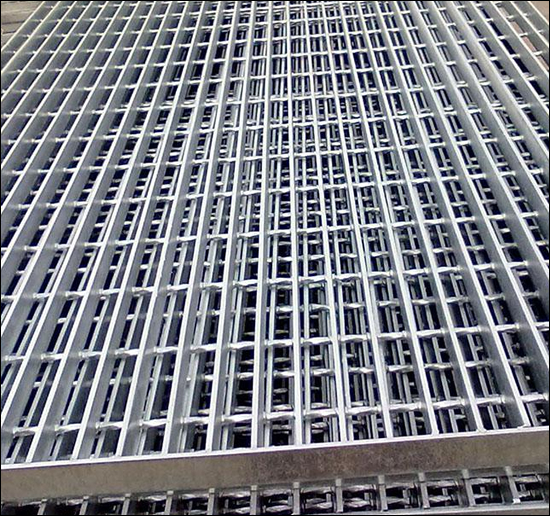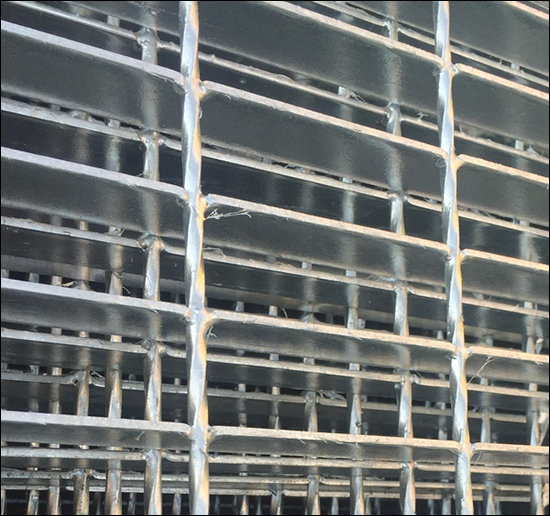Forge welded grating is made by electroforging process: The cross bars are welded to bearing bars by applying heat and pressure to create a strong, uniform, and durable grid. Forge welded steel bar gratings are most popular and versatile industrial grating types, available in a variety of materials, spans, bar thicknesses and loading capacities. Forge welded or pressure welded grating is commonly used as heavy duty gratings for static and dynamic loading in the form of walkways, safety barriers, drainage covers, platforms, ventilation grates and stair treads.
Benefits of Forge Welded Grating:
Material: Carbon Steel,Stainless Steel
Surface: Plain smooth,serrated
Finish: Mill Finish Clean Steel, Black Primer, H.D. Galvanized
Material Standard:
Mild steel - High quality mild steel for load bearing bars, material grade of ASTM A36, BS4360 Grade 43A and JIS G3101 SS400, KSD3505 SB41. This is particularly beneficial where a floor is subjected to wheel loads, as deflection becomes a subordinate consideration to the ability of the load bearing bar to withstand high stress.
Forged Floor Grating can also be manufactured from stainless steel. The normal grade used are SS304 and 316.
Manufacturing Standards
Qindelin Gratings are designed and manufactured in accordance with relevant international standards.
Common Sizes:
Pitch of Bearing Bar
A center distance between the two bearing bars adjacent to each other.
*Common pitch : 30mm & 40mm
Other : 12.5mm, 15mm, 25mm, 60mm
Pitch of Cross Bar
A center distance between the two cross bars adjacent to each other.
*Standard pitch : 50mm & 100mm.
NOTE
Different spacing of bearing bar & Cross bar can also be manufacture upon request.
Uses:
Heavy-duty forge welded gratings can be provided for many construction and industrial applications:
Electroforged Grating
USA Standard
1-1/2" Electro Forged Grid (Grating)
Material: Stainless Steel With Smooth Surface. Type: G1.
Sheet size: 0.91 Mt.(3 Feet) X 6.10 Mt.(20 Feet)
Heavy Welded Bar Grating
Galvanized steel welded grating panels
Width 24", Span 60"
1/4" x 1" Bearing Bars, 1-3/16" center to center spacing.
Heavy welded cross bars on 4" centers
Smooth surface, Load Banded with equal gauge stubs welded ends.
S355JR 60 x 5 Forge-Welded Gratings, Steel, Non galvanized
Steel grating not galvanized
Mesh 41.7 x 76.2
Flat carrier 60 x 5
Material S355JR
Finish: Clean steel
Mat size:
6100 mm x 1000 mm
Polish standards
Forge Welded Grating can be supplied with Chequered Steel Plate

Flat Bar Grating welded, hot dipped galvanized finish
Material: Carbon Steel with galvanized finishing
Panel Width x length:Im x 6m
Details:
Non-serrated/smooth bar grating.
Bearing bar size: 1-1/4"x 3/16"
The bearing bars 19/16's(1-3/16)inches on center
Cross bars spaced at 4 inches on center.
Types of bearing bar: Flat bars; made from steel strip or slit sheet, or rolled.
Finishing:Hot Dip Galvanizing, zinc coating minimum average coated per Standards AS1650,BS729 and ASTM A123.
Grating safety guard plate: Checker plate, steel, hot dipped galv.
Anti Skid Forge Press Welded Steel Grating - for industrial platforms

Presswelded steel gratings, not galvanized, natural steel colour
The bearing bars placed edgeways connected with twisted cover rods, embedded with a force of 1000KN, welded at 2500KVA.
Mesh size 34x76mm
Bearing bar 30x3mm
Size of panel 5800x1000mm
Material S235 Low carbon steel
Finish: Zinc coated
Framed
Bearing bar sizes also available:
20x7mm, 30x1mm, 34x3mm, 41x4mm
Anti-skid protection: Notched bearing bar
Welded Metal Bar Grating - for Oil and Gas Industry

Industrial grating, welded, details:
Sheet size 6100 (6000) x 1000mm
Cell size 34x38 / 30x3 mm
Material: Steel S235
Finish:Corrosion-resistant, hot-dip galvanized by EN ISO 1461: 2009
No borders
Dimensions in accordance with RAL GZ 638
Standard: DIN 24537-1:2006-04, DIN 24531-1
Technical Terms Applied for Welded Bar Gratings
U = safe uniform load, psf
C= safe concentrated load, pfw
D = deflection, inches
E =modulus of elasticity,29,000,000 psi
F =fiber stress,18,000 psi
Material: ASTM A-569 standard
Defiection: Spans and loads to the right of the bold line exceed 1/4"deflection for uniform load of 100 psf which provides safe pedestrian comfort. These can be exceeded for other types of loads with engineer's approval.
Serratet Bars: For serrated grating, the depth of grating required for a specified load is 1/4"deeper than standard.
General: Loads and deflections are theoretical and based on static loading.
Forge Welded Bar Grating Technical Specification Lists
| Material Standard | ASTM A36, A1011, A569, Q235, S275JR, Stainless steel 304/316, Mild steel & Low carbon steel, etc |
| Bearing Bar (Width x Thickness) |
25x3, 25x4, 25x4.5, 25x5, 30x3, 30x4, 30x4.5, 30x5, 32x5, 40x5, 50x5, 65x5, 75x6, 75x10…..100 x10mm etc; |
| Bearing Bar Pitch | 12.5, 15, 20, 23.85, 25, 30, 30.16, 30.3,32.5, 34.3, 35, 38.1, 40, 41.25, 60, 80mm etc. US standard: 19-w-4, 15-w-4, 11-w-4, 19-w-2, 15-w-2 etc. |
| Twisted Cross Bar Pitch | 38.1, 50, 60, 76, 80, 100, 101.6, 120mm, 2'' & 4'' etc |
| Surface Treatment | Untreated(black), Hot-dipped galvanized, Powder coated, Electroplate, Painting or as per customers' requirement. |
| Grating Style | Plain / Smooth, Serrated / Teeth, I bar, Serrated I bar |
We have complete quality control system throughout the total fabrication, particularly of the welding.
Structural welds are crucial for strength between joining pieces of structural grating steelwork.
Acceptable Welding Processes
Shielded Metal Arc Welding SMAW
Gas Tungsten Arc Welding (Tig) GTAW
Gas Metal Arc Welding (Mig/Mag) GMAW
Submerged Arc Welding SAW
Flux Cored Arc Welding FCAW
The above processes may be used in combination, but the qualification test shall also use the same combination and sequence of processes.
Choice Welding Filler Materials
All filler material shall be selected to match the mechanical and chemical requirements of the base materials to be joined.
Filler metals for welding materials of differing strengths and toughness together shall be required to develop only the same strength and toughness as the lower quality member.
Tack welds shall be made with the same welding process and consumables that are used for root pass welding.
Electrodes, filler wires, fluxes etc., must be readily identifiable and each type kept separate from all other types of different consumables.
For submerged arc welding on ferritic materials a neutral (non-active) flux which does not increase the alloying content shall be used. For submerged arc welding, the filler wire shall not exceed 5mm dia. and the heat input shall be restricted to less than 39,000J/cm.
All welding electrodes shall comply with E70XX and shall meet filler metal requirements given in AWS D1.1.
Weld Joint Preparation and Treatment
Weld bevels may be made by machining, grinding, or flame-cutting and grinding. The joint surface shall be reasonably smooth and true. Materials that require preheat for welding shall be pre-heated in the same manner for flame-cutting, arc gouging and tack welding.
Parts to be joined by fillet welds shall be brought together as closely as possible. The gap between facing surfaces of lap joints should not exceed 2mm. If the separation is greater than 2mm after straightening and assembly the leg of the fillet weld shall be increased by the amount of the separation but the increase shall not exceed 5mm.
The use of filler or packing pieces for excessive gaps in not permitted. Joint misalignment or excess root openings for single side welds, shall be corrected by applying weld build-up to the bevel face, as permitted and qualified by welding procedure. On oblique intersection tubular joints the build-up shall be applied to the minor member. The corrected root opening shall be capable of closure by a single pass of the approved electrode. Weaving techniques shall not be employed for closure of excessively wide root gaps. Arc gouging to widen tight grooves will be permitted only when followed by grinding to bright metal.
All surfaces to be welded shall be free of paint, oil, dirt, scale, oxides, and all other foreign matter that may be detrimental to weld quality.
Fit up lugs, strongbacks, cleats and other temporary welded attachment shall be removed by oxy-fuel gas cutting. The attachment shall cut above the surface of attached parts and the remaining weld and metal ground flush to the parent plate.
All arc strikes, burrs, gouges, and other superficial surface damage shall be dressed smooth and flush by grinding.
Welds are to be examined by non-destructive testing techniques, surface finished as required by the applicable codes and the examination technique concerned.
Qindelin Steel Grating Engineering Corporation
Add: New Development Zone, Dezhou, Shandong, China
URL: https://www.steelgrating.org
Email: sale@steelgrating.org
